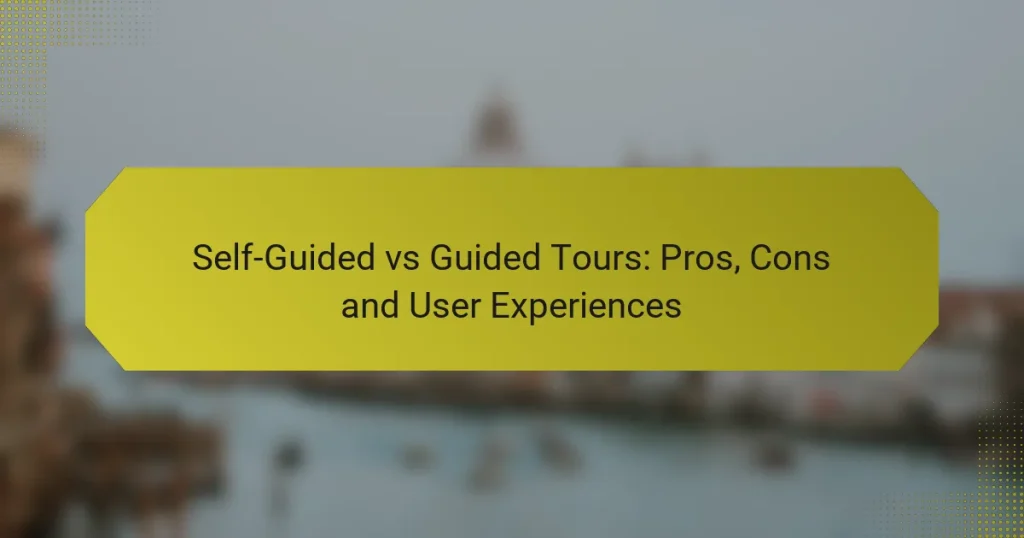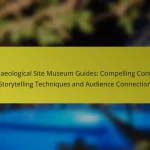When choosing between self-guided and guided tours, travelers must weigh the benefits and drawbacks of each option. Self-guided tours provide the freedom to explore at one’s own pace, catering to personal interests, while guided tours offer expert insights and structured experiences. Understanding these differences can help travelers make informed decisions that align with their preferences and enhance their overall journey.

What are the pros of self-guided tours?
Self-guided tours offer travelers the freedom to explore at their own pace, allowing for a more personalized experience. They are often more flexible and can be tailored to individual interests, making them an appealing option for many adventurers.
Flexibility in schedule
Self-guided tours provide the ability to create your own itinerary, meaning you can spend as much or as little time at each location as you wish. This flexibility allows for spontaneous detours or extended stays at places that capture your interest, enhancing the overall travel experience.
For instance, if you find a charming café or a scenic viewpoint, you can take the time to enjoy it without worrying about a group schedule. This can be particularly beneficial in destinations with numerous attractions or natural wonders.
Cost-effectiveness
Self-guided tours can be more budget-friendly compared to guided tours, as you can save on costs associated with tour guides and transportation. Many attractions offer free entry or reduced prices for self-guided visitors, allowing you to allocate your budget to other experiences.
Travelers can also choose to use public transportation or walk, which can significantly reduce expenses. For example, exploring a city on foot or by local bus can be much cheaper than hiring a private guide or taking a taxi.
Personalized experiences
With self-guided tours, you have the opportunity to tailor your journey to your specific interests, whether that’s art, history, or local cuisine. This personalization allows you to focus on what truly excites you, rather than adhering to a preset agenda.
Additionally, you can incorporate unique experiences, such as visiting local markets or attending cultural events that may not be included in a standard guided tour. This can lead to a richer and more authentic understanding of the destination.

What are the cons of self-guided tours?
Self-guided tours offer flexibility but come with several drawbacks. These include a lack of professional insight, the risk of overlooking key attractions, and the potential for a less enriching experience overall.
Lack of expert guidance
One major downside of self-guided tours is the absence of expert guidance. Without a knowledgeable tour guide, travelers may miss out on historical context, local anecdotes, and cultural nuances that enhance the experience.
For instance, while exploring a city, a guide might share stories about significant landmarks that aren’t included in guidebooks. This can lead to a more engaging and informative visit, which self-guided tours often lack.
Potential for missed highlights
Self-guided tours can result in missed highlights due to the absence of a structured itinerary. Travelers may not be aware of must-see attractions or hidden gems that are easily overlooked without a guide’s recommendations.
To mitigate this risk, it’s advisable to research key sites beforehand and create a checklist. This ensures that important locations are included in the itinerary, enhancing the overall experience and preventing regret over missed opportunities.

What are the pros of guided tours?
Guided tours offer several advantages, including access to expert knowledge, structured itineraries, and opportunities for social interaction. These benefits can enhance the overall travel experience, making it more informative and enjoyable.
Access to expert knowledge
One of the main advantages of guided tours is the access to expert knowledge provided by the tour guide. Guides often have extensive training and experience, allowing them to share insights and stories that enrich the experience. This can be particularly valuable in historical sites or cultural landmarks where context enhances understanding.
For example, a guided tour of the Colosseum in Rome can reveal fascinating details about ancient Roman life that a visitor might miss when exploring alone. This depth of knowledge can significantly elevate the experience, making it more memorable and educational.
Structured itineraries
Guided tours typically come with structured itineraries that help maximize time and ensure that key attractions are included. This organization can be especially beneficial for travelers with limited time or those unfamiliar with the destination. A well-planned itinerary can prevent the stress of navigating unfamiliar areas.
For instance, a guided tour in Paris might include visits to the Eiffel Tower, Louvre Museum, and Notre-Dame Cathedral, all in a single day, allowing participants to see major sights without the hassle of planning logistics themselves.
Social interaction opportunities
Guided tours provide opportunities for social interaction with fellow travelers, which can enhance the experience. Meeting new people and sharing experiences can lead to lasting friendships and a sense of camaraderie. This social aspect is particularly appealing for solo travelers or those looking to connect with others.
Many guided tours encourage group activities, such as shared meals or discussions, which can foster a sense of community. For example, a group hike in the Swiss Alps might include shared meals where participants bond over their experiences, making the journey more enjoyable and enriching.
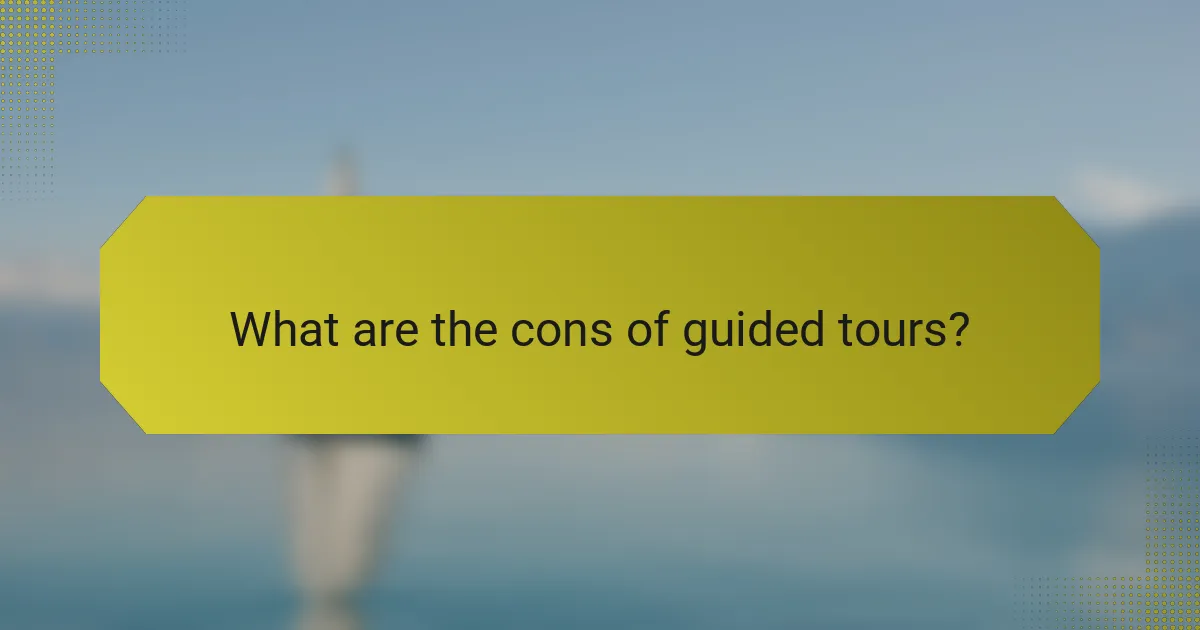
What are the cons of guided tours?
Guided tours can limit personal exploration and often come with drawbacks that may not suit every traveler. While they offer structured experiences, the restrictions can detract from the enjoyment of a trip.
Less flexibility
Guided tours typically follow a strict itinerary, which can hinder spontaneous exploration. Travelers may find themselves rushed through attractions or unable to spend extra time at places of interest. This lack of flexibility can be frustrating for those who prefer to explore at their own pace.
For example, if a tour includes a popular museum, participants might only have an hour to explore, even if they wish to linger longer. This structure can lead to missed opportunities for deeper engagement with local culture and history.
Higher costs
Guided tours often come with a higher price tag compared to self-guided options. The costs can include not only the tour price but also additional fees for attractions, meals, and transportation. Depending on the destination, these expenses can add up significantly.
For instance, a guided tour in Europe might range from €100 to €300 per day, while a self-guided approach could allow for a budget of €50 to €150, depending on personal choices. Travelers should weigh these costs against the benefits of convenience and expertise offered by guides.
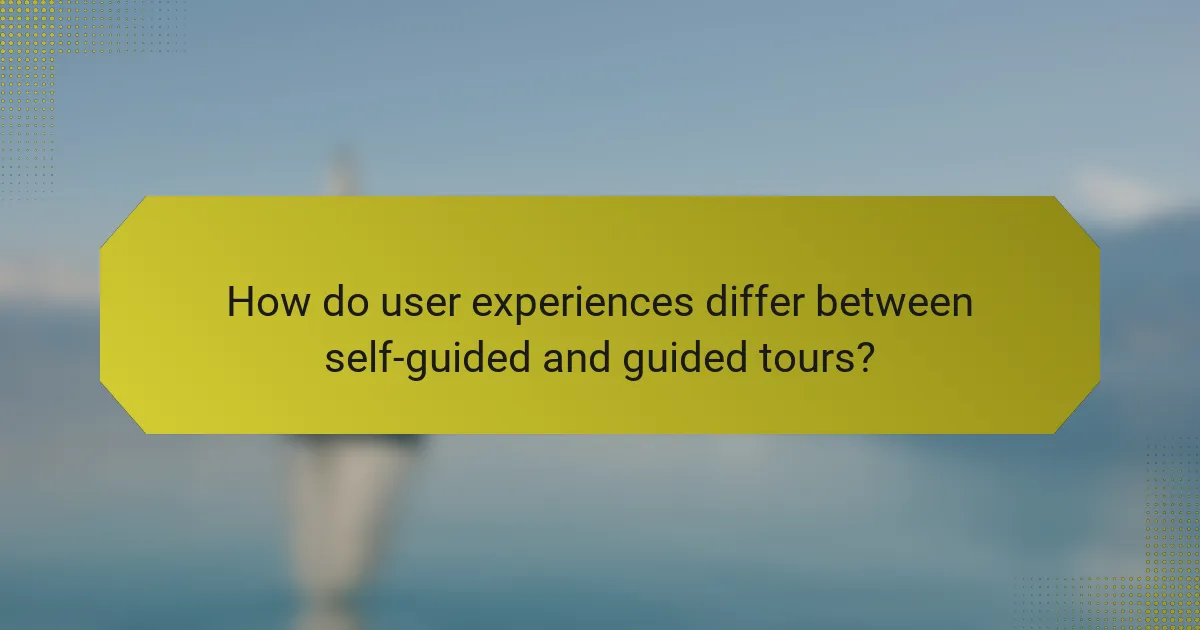
How do user experiences differ between self-guided and guided tours?
User experiences in self-guided and guided tours vary significantly based on personal preferences and expectations. Self-guided tours offer flexibility and independence, while guided tours provide structure and expert insights, impacting overall satisfaction and engagement.
Varied satisfaction levels
Satisfaction levels can differ greatly between self-guided and guided tours. Many travelers appreciate the freedom of self-guided tours, allowing them to explore at their own pace and focus on areas of personal interest. However, some may find guided tours more fulfilling due to the added context and storytelling provided by a knowledgeable guide.
In a survey of travelers, those on guided tours often report higher satisfaction rates, particularly in complex destinations where local knowledge enhances the experience. Conversely, self-guided tour participants may express frustration if they encounter difficulties navigating or lack sufficient information.
Different engagement styles
Engagement styles in self-guided versus guided tours reflect distinct approaches to exploration. Self-guided tours encourage personal discovery, allowing travelers to linger at attractions or skip less interesting sites. This autonomy appeals to those who prefer a tailored experience.
On the other hand, guided tours foster group interaction and shared experiences, which can enhance learning and enjoyment through discussions and questions. Travelers who thrive on social engagement may find guided tours more rewarding, as they often include opportunities to connect with fellow participants.

What factors should you consider when choosing between self-guided and guided tours?
When deciding between self-guided and guided tours, consider your travel goals, personal preferences, and the specifics of your destination. Each option has distinct advantages and drawbacks that can significantly impact your overall experience.
Travel goals and preferences
Your travel goals play a crucial role in determining whether a self-guided or guided tour is more suitable. If you seek flexibility and independence, self-guided tours allow you to explore at your own pace and choose your own itinerary. Conversely, if you prefer structured experiences with expert insights, guided tours can enhance your understanding of the destination.
Consider your comfort level with navigation and local customs. Self-guided tours often require more planning and familiarity with the area, while guided tours provide a safety net through organized logistics and local knowledge.
Destination specifics
The characteristics of your destination can influence your choice between self-guided and guided tours. For example, in urban settings with extensive public transport, self-guided tours can be efficient and enjoyable. However, in remote or less accessible areas, guided tours may be necessary to ensure safety and provide access to key attractions.
Additionally, consider the availability of resources such as maps, apps, or local guides. Some destinations may have well-developed self-guided tour options, while others may only offer guided experiences. Researching these aspects can help you make an informed decision that aligns with your travel style and destination.
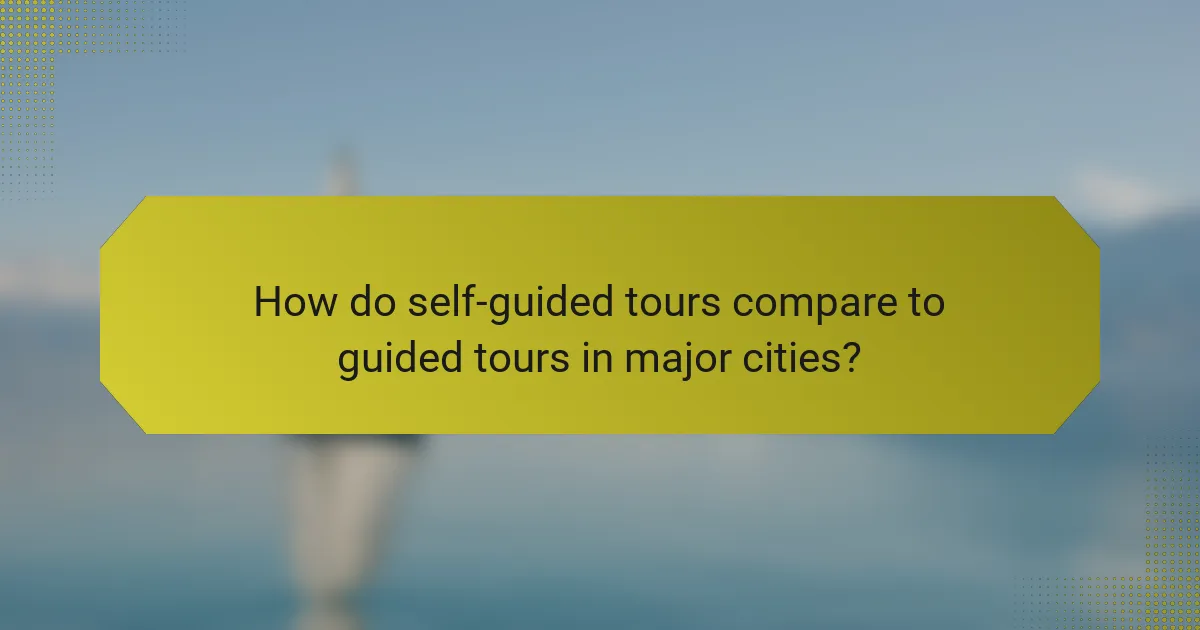
How do self-guided tours compare to guided tours in major cities?
Self-guided tours offer flexibility and independence, allowing travelers to explore at their own pace, while guided tours provide structured experiences with expert insights. Choosing between the two depends on personal preferences, budget, and desired depth of knowledge about the destination.
Popular self-guided options in New York
In New York, self-guided tours can include walking routes through iconic neighborhoods like Greenwich Village or the Lower East Side. Many apps and websites offer curated itineraries, allowing users to discover landmarks, local eateries, and hidden gems without a set schedule.
Some popular self-guided options are the New York City Subway map tours and audio guides available for major attractions like the Metropolitan Museum of Art. These resources enable visitors to tailor their experiences and spend as much time as they wish at each site.
Top guided tours in Paris
Paris offers a variety of guided tours, ranging from classic sightseeing bus tours to specialized experiences like food tastings or art-focused excursions. These tours often include knowledgeable guides who share historical context and personal anecdotes, enhancing the overall experience.
Notable guided tours include the Louvre Museum tours, which help navigate the vast collection efficiently, and Seine River cruises that provide a unique perspective of the city’s landmarks. Prices for guided tours can vary widely, typically ranging from €30 to €150 depending on the length and exclusivity of the experience.

What are emerging trends in the tour industry?
Emerging trends in the tour industry reflect a growing demand for personalized experiences and sustainable travel options. Tour operators are increasingly adopting technology and innovative practices to enhance customer engagement and streamline operations.
Increased Demand for Personalization
Travelers are seeking more tailored experiences that cater to their individual preferences and interests. This trend has led to the rise of customizable tours, where participants can select specific activities, destinations, and even the pace of their journey. For example, some companies now offer modular itineraries that allow travelers to mix and match different experiences.
To capitalize on this trend, tour operators should invest in customer relationship management systems that track preferences and feedback. This data can help create more engaging and relevant offerings, enhancing customer satisfaction and loyalty.
Focus on Sustainable Tourism
As awareness of environmental issues grows, many travelers are prioritizing sustainability when choosing tours. This has prompted operators to adopt eco-friendly practices, such as minimizing waste, supporting local communities, and promoting conservation efforts. For instance, some tours now include carbon offset options or partner with organizations focused on environmental protection.
Tourists can look for certifications or partnerships that indicate a commitment to sustainability when selecting a tour. Operators should clearly communicate their eco-friendly initiatives to attract environmentally conscious travelers.
Integration of Technology
Technology is transforming the tour industry, with advancements in mobile apps, virtual reality, and artificial intelligence enhancing the travel experience. Many companies are now offering mobile apps that provide real-time information, interactive maps, and personalized recommendations during tours.
Operators should consider leveraging technology to improve operational efficiency and customer engagement. Investing in user-friendly platforms can streamline booking processes and enhance communication with travelers before, during, and after their tours.
Rise of Remote and Virtual Tours
The COVID-19 pandemic accelerated the popularity of remote and virtual tours, allowing people to explore destinations from the comfort of their homes. These tours often include live guides and interactive elements, making them engaging and informative.
While virtual tours may not replace in-person experiences, they can serve as a valuable marketing tool. Operators can use them to showcase destinations and entice potential customers to book future trips.
